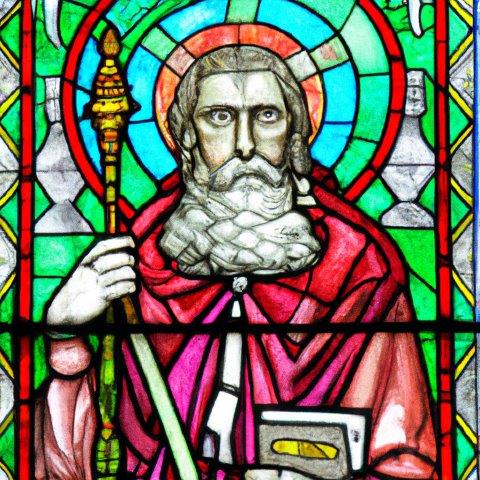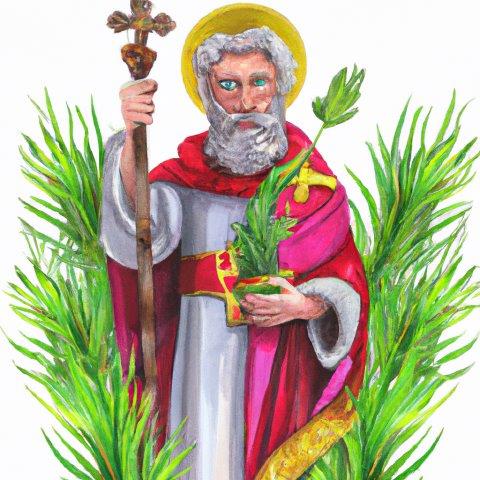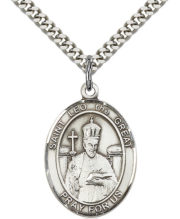Saints
St. Leo the Great
St Leo the Great, descended from a noble Tuscan family but was born in Rome, Italy. He became Archbishop of the Church of Rome under Popes Celestine I and Sixtus III. When Sixtus III died, the Roman clergy chose Leo as his successor to the Papal throne, and he was raised to St. Peter’s throne on Sunday, September 29, 440.
St. Leo the Great Biography
 “St. Leo the Great was a Pope of the Catholic Church, serving from 440 to 461 AD. He is considered one of the most important figures of the patristic period and one of the four great Latin Doctors of the Church. Born in Tuscany, Italy, he became a deacon in Rome, and was later elected Pope in 440 AD.
“St. Leo the Great was a Pope of the Catholic Church, serving from 440 to 461 AD. He is considered one of the most important figures of the patristic period and one of the four great Latin Doctors of the Church. Born in Tuscany, Italy, he became a deacon in Rome, and was later elected Pope in 440 AD.
During his pontificate, Leo played a significant role in the development of the doctrine of the Trinity, and is known for his writings on the nature of Christ, including his Tome, which was read at the Council of Chalcedon in 451. This council clarified the Christological controversy, which had arisen in the 5th century, and reaffirmed the orthodox understanding of the nature of Christ as fully human and fully divine.
Leo also played a key role in resolving the Acacian Schism, which had divided the Eastern and Western Churches for over 30 years. Through diplomatic efforts and personal persuasion, he was able to reconcile the two sides and bring about a unified Christendom.
Leo was also known for his role in defending Rome from the invasions of the Germanic tribes. In 452, he personally met with Attila the Hun, who had been threatening to invade Rome, and was able to convince him to turn back and not attack the city. This earned him the title “”Leo the Great””.
Leo was known for his strong leadership and his efforts to maintain the unity of the Church. He sent legates, or representatives, to various councils and synods throughout the empire in order to ensure that the decisions made were in line with Church doctrine and to resolve disputes. He also worked to strengthen the authority of the papacy and to establish Rome as the preeminent center of Christianity.
Leo’s sermons and letters, many of which have been preserved, are considered important examples of patristic literature. They reveal much about the man and his theology and give insight into the mind of the 5th century Church. His sermons on the feast of Easter, Christmas, and other festivals were to become models for the liturgical year for centuries.
Leo’s writings reflect his strong belief in the importance of the episcopal office and the role of the Pope as the head of the church. He saw the role of the Pope as the shepherd of the flock of Christ, entrusted with the care of the entire Christian community and responsible for preserving the unity and doctrine of the Church.
Leo died on November 10, 461. He was buried in the Basilica of Saint Peter in Rome. He was canonized as a saint in the 8th century. The Catholic Church celebrate his feast day on April 11th, Eastern Orthodox Church on February 18th. He is known as one of the most important Pope in the history of the Catholic Church, his teachings and actions helped shape the Church’s development, particularly the understanding of the person of Christ and the role of the Pope in the Church.
The Life of St. Leo the Great
St. Leo the Great’s victories over the heretics-Manicheans, Arians, Apollinarism, Nestorians, Pelagians, Eutychianism, Novatians and Donatists-prove his zeal for the purity of the Faith. While the Eastern empire was assailed by heretical teachings, the Western was laid waste by the attacks of barbarians.
Attila, the Hun, with abundant resources of his plunders, began a gruesome attack against Rome. Pope Leo, at the request of the Roman citizenry, went to meet Attila with the, “the scourge of God”, saving the Holy City and averting the destruction of the surrounding country. It was near Ravenna that they met, and unexpectedly, Attila received the Pope with great honor, and through his suggestion concluded a treaty of peace with the empire on the condition of an annual tribute.
Baronius, a writer of the 8th century, states that Attila saw two venerable personages, supposedly the Apostles St. Peter and St. Paul, standing by the Pope as he spoke. Two years later Rome fell to the Vandals. The Holy Father prevailed upon the Arian Vandal king to restrain his troops from slaughter and burning and to be satisfied with plundering the city, thus saving it from destruction.
Because of his humility, mildness and charity, Pope Leo was reverenced and loved not only by emperors and princes, but by all ranks of people, even infidels and barbarians. His dogmatic letter to Flavian, Patriarch of Constantinople, in which he defined the Catholic belief on the twofold nature and one person in Christ, was acclaimed as the teaching of the Church at the Council of Chalcedon in 451. This great Pope filled the Holy See twenty-one years. one month and thirteen days, dying on November 10, 461. He shares the title of “the Great”, with only two other Popes-Gregory I and Nicholas I. In 1754, St. Leo was declared a Doctor of the Church.
Prayers to St. Leo the Great
God our Father,
you will never allow the powers of hell
to prevail against your Church,
founded on the rock of the apostle Peter.
Let the prayers of Pope Leo the Great
keep us faithful to your truth
and secure in your peace.
Through our Lord Jesus Christ, your Son,
who lives and reigns with you
in the unity of the Holy Spirit,
one God, for ever and ever.
Amen.
Prayer to St. Leo the Great
Dear St. Leo the Great,
You were a man of great wisdom and faith, dedicating your life to the service of the Church and the spreading of the gospel. I ask for your intercession as I seek to grow in my own faith and to serve others.
May your example inspire me to be a person of deep wisdom, unwavering faith, and selfless service.
Amen.
Prayer to St. Leo the Great
St. Leo the Great,
You were a man of great courage and conviction, always standing up for what was right and defending the faith against those who would seek to undermine it. Help me to have the courage to do what is right, even in the face of opposition, and to always hold fast to my faith.
May your devotion to God and your love for his people fill me with the strength and wisdom I need to be a faithful witness in a world that often seeks to undermine the truth.
Amen.
Prayer to St. Leo the Great
O St. Leo the Great,
You were a man of great wisdom and holiness, always striving to live a life that was pleasing to the Lord. Help me to grow in my own wisdom and holiness, and to always seek to do the will of God.
May your example inspire me to be a person of deep faith, sincere devotion, and unwavering commitment to the Lord.
Amen.
Popular St. Leo the Great Medal and St. Leo the Great Rosary
St. Leo the Great: Patron Saint of Popes and Butchers
 St. Leo the Great is the patron saint of popes and butchers. He was a Pope of the Catholic Church in the 5th century, known for his leadership during a time of great political and theological turmoil in the Church and the Roman Empire.
St. Leo the Great is the patron saint of popes and butchers. He was a Pope of the Catholic Church in the 5th century, known for his leadership during a time of great political and theological turmoil in the Church and the Roman Empire.
St. Leo the Great is recognized as the patron saint of popes because of his strong leadership and commitment to maintaining the unity of the Catholic Church. He was instrumental in settling theological disputes, such as the Nestorian heresy, which threatened the unity of the Church. His writings, including his sermons and letters, are considered some of the most important in the history of the Church, and continue to be studied and respected to this day.
In addition to being recognized as the patron saint of popes, St. Leo the Great is also recognized as the patron saint of butchers. This is because, according to legend, he once saved Rome from famine by miraculously providing meat during a time of food shortage. As a result, butchers and those who work in the meat industry have adopted St. Leo as their patron saint, seeking his intercession for protection and success in their work.
St. Leo the Great is remembered for his strong leadership, his commitment to preserving the unity of the Church, and his compassion for the people of Rome. He is revered as a powerful intercessor, and his intercession is sought for a variety of needs, including guidance for those in leadership positions, protection for those who work in dangerous or challenging occupations, and comfort for those who are suffering or in need.
Reflection on the feast day of St. Leo the Great
 The feast day of St. Leo the Great is on November 10th.
The feast day of St. Leo the Great is on November 10th.
On the feast day of St. Leo the Great, we celebrate the life and legacy of one of the great saints of the early Church. He was a Pope of the Roman Catholic Church who served from 440 to 461. He is considered a Doctor of the Church and one of the most important figures in the development of the doctrine of the papacy.
St. Leo’s papacy was marked by his tireless efforts to strengthen the Church and to defend the faith against the many challenges it faced during his time. He worked to combat heresies, to uphold the authority of the Pope, and to promote unity among the faithful. He also played a critical role in the Council of Chalcedon, which helped to clarify the doctrine of the Trinity and the nature of Christ.
St. Leo’s example teaches us the importance of leadership in the Church. He reminds us that the role of the Pope is not just to govern the Church but also to teach and defend the faith. He shows us that the Pope must be a strong leader, a wise teacher, and a humble servant of the faithful. He inspires us to look to the Pope for guidance, and to support him in his role as the Vicar of Christ on earth.
St. Leo’s life also serves as a reminder of the importance of unity in the Church. He understood that the Church is one body, united in its faith and in its love for God. He worked tirelessly to promote unity and to heal divisions within the Church. He teaches us that the Church is stronger when it stands together and that division weakens it.
In conclusion, as we celebrate the feast day of St. Leo the Great, let us remember the example of this great saint and his dedication to the Church. May we strive to follow his example, to support the Pope and to deepen our relationship with God through humility, unity, and faith.
Discover biographies, prayers, and reflections for more than 400 Catholic Saints
Next up: Biography of St. Lidwina of Schiedam
Also check out our handmade St. Leo the Great Medal and St. Leo the Great Rosary and St. Leo the Great Rosary Bracelet .




